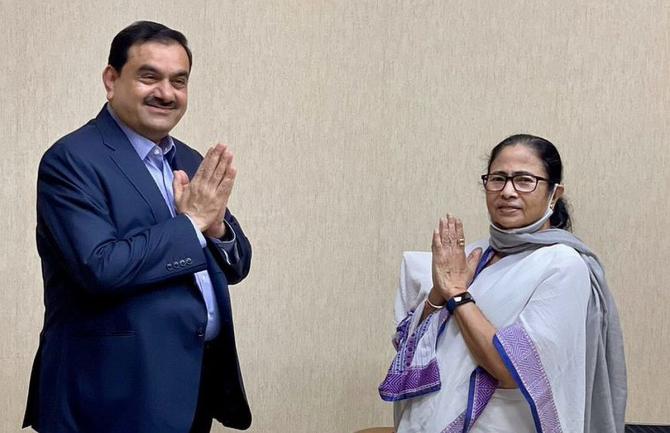How Mamata can woo big-ticket projects to Bengal

The words ‘industry’, ‘industrial development’, ‘jobs’, and ‘employment’ have been ringing with higher frequency since Mamata Banerjee stepped into her third term with landslide victory after a high-octane election last year.
“Our government’s next target is industrial development,” the chief minister (CM) had been heard stating at different public meetings in the past few months — perhaps setting the tone for the sixth edition of the Bengal Global Business Summit (BGBS) slated for later this month.
Investor summits by any state are about intent, big numbers, and tall claims.
Yet in competitive federalism, its importance as a marketing tool is undeniable.
Te business proposed in the earlier five editions of BGBS added up to Rs 12.35 trillion, according to its website.
The sixth is unlikely to fall behind.
Roadshows have been held in Delhi, Chennai, and Hyderabad by a state delegation of bureaucrats, led by West Bengal Industrial Development Corporation Chairman Rajiva Sinha, in partnership with industry bodies.
Across three cities, 70-80 one-to-one meetings have been held.
Through these meetings and BGBS, the state government hopes to lay the groundwork for investment.
“The BGBS is a platform to showcase the strengths of the state and build partnerships that we can take forward later,” said Sinha.
“Fourteen countries have confirmed participation,” he added.
But will the sixth edition of the summit bring in big-ticket investment with the seeming return of private-sector capital expenditure and Banerjee’s stated focus on industry?
Industry has always been a priority, said Sinha, adding, “In its third term, it has got more focused.”
The focus of the Trinamool Congress government has broadly been thus: the first term was about physical and social infrastructure development.
The second pivoted around social and welfare schemes. In its third term, the target is ‘industrial development’.
But industry is a necessity, even for the continuance of policies adopted in the past decade.
“The policies have been geared towards the underprivileged.
“But big industries are required to shore up state coffers.
“Without revenues, what will the state redistribute?” asked Abhirup Sarkar, former professor of economics, Indian Statistical Institute.
That’s a predicament the Left Front faced after militant trade unionism led to a flight of capital through the 1970s, the 1980s, and later.
The first few years of Communist rule saw dramatic improvement in foodgrain production, with the implementation of land reforms and the Boro revolution.
The rate of growth of foodgrain production nearly shot up to 7 per cent in the 1980s, but then the laws of diminishing returns set in; growth fell to 2 per cent between 1991 and 2006.
Realising the stagnation in farm output, then CM Buddhadeb Bhattacharjee took up industrialising West Bengal on a war footing. How that panned out is another story altogether.
“Agriculture in West Bengal has always performed well, even under the Left.
“But agriculture alone cannot bring in prosperity.
“We have to focus on industry and information technology (IT) because the per capita income is behind some major states,” said Sarkar.
West Bengal’s growth has largely rested on micro, small and medium enterprises (MSMEs).
At 8.9 million, it accounts for 14 per cent of the total MSME units and is second only to Uttar Pradesh. But many are marginal and barely persisting.
But in the past decade, West Bengal has also netted some big names and projects.
A clutch of companies has taken up space at the proposed IT hub — Bengal Silicon Valley.
Tata Consultancy Services, which employs around 50,000 in Bengal, according to the state Budget statement 2022-2023, has taken up 20 acres; Reliance Jio has taken up 40 acres for a high-technology data centre; and Airtel as well.
The Infosys development centre and Wipro’s second campus are works in progress.
Some cement companies like JSW Cement have also set foot in the state.
Recently, IT services firm Mindtree announced the inauguration of its first development centre in Kolkata.
Mamata 3.0 also appears to have piqued the interest of one of India’s biggest business groups — Adani.
Gautam Adani, chairman, Adani Group, met Banerjee in Kolkata in December and discussed ‘investment scenarios’.
Last month, in a close bid for Bengal’s proposed greenfield port at Tajpur in Purba (East) Medinipur — touted as game-changing for West Bengal — Adani Ports and Special Economic Zone emerged the highest bidder, or selected/qualified bidder.
The other contender was JSW Infrastructure.
The state government, however, is yet to announce the winner.
But large industries will invest if the incentive schemes are revived, believe some who are already invested in the state and looking to expand.
The state government has sector-specific schemes, including one for MSMEs.
Sops are what investors generally look for when deciding on large projects, although the issue did not come up during the recent BGBS roadshows, observed an industry representative.
As industrial development of West Bengal remains a work in progress, Banerjee may need to conjure up resources to woo big-ticket projects in the state.
There are other aspects that may warrant attention.
The communication by IFB Agro to stock exchanges on the subscription of electoral bonds to deal with ‘excise-related issues’ being a case in point.
Source: Read Full Article

